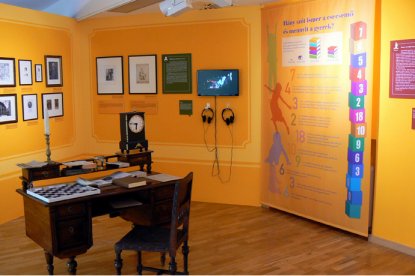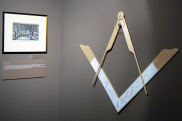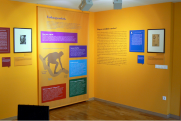2025. December 23. Tuesday
The Museum of the Hungarian Language - Sátoraljaújhely - Széphalom
|
|
Address: 3988, Sátoraljaújhely - Széphalom Kazinczy u. 275.
Phone number: (47) 521-236
E-mail: info@nyelvmuzeum.hu
Opening hours: Tue-Sun 9-17
|
Museum tickets, service costs:
|
Ticket for adults
|
600 HUF
|
/ capita
|
|
Ticket for students
|
300 HUF
|
/ capita
|
|
Ticket for pensioners
|
300 HUF
|
/ capita
|
|
Photography
|
500 HUF
|
The Petőfi Literary Museum – Museum of the Hungarian Language opened the temporary exhibition on 27 March 2014. The exhibition is not based on static information, rather on museum pedagogical information, a role play during which visitors can gain interesting and fun information but may also become advertising boards of their own and their surroundings language use as well.

During the role-play that serves as frame, the visitor may take the of three different people, and will see the various content through magical glasses, and will pass the tracks solving problems. The acquisition of knowledge is linked by physical movement, checking out spectacular multi-media viewing points to the creation of languages as well as the inexhaustible themes of their acquisition, use, recording, oral and written communication.
The aim of the exhibition is to make teaching of Hungarian grammar that is becoming less popular and is often neglected in favour of literature more attractive and also to describe current problems of linguistics in a comprehensible manner.
Another key objective of the exhibition is to strengthen through the experiences in a more authentic manner the attachment to mother tongue, promote emotional relationship to changes in the language, to raise awareness, and to demonstrate through practical examples the flexibility of the Hungarian language, its adaptability to changes.

During the role-play that serves as frame, the visitor may take the of three different people, and will see the various content through magical glasses, and will pass the tracks solving problems. The acquisition of knowledge is linked by physical movement, checking out spectacular multi-media viewing points to the creation of languages as well as the inexhaustible themes of their acquisition, use, recording, oral and written communication.
The aim of the exhibition is to make teaching of Hungarian grammar that is becoming less popular and is often neglected in favour of literature more attractive and also to describe current problems of linguistics in a comprehensible manner.
Another key objective of the exhibition is to strengthen through the experiences in a more authentic manner the attachment to mother tongue, promote emotional relationship to changes in the language, to raise awareness, and to demonstrate through practical examples the flexibility of the Hungarian language, its adaptability to changes.


